Oop(object oriented programming)
- 2. 2 Paradigm Shift in Programming Programs: Data, Statements, Functions Programming with flowchart Program = Data Structure + Algorithms Structured Programming – Sequence Instructions – Decision Making – Looping
- 3. ALGORITHMS • An algorithm is a sequence of precise instructions for solving a problem in a finite amount of time. Properties of an Algorithm: • It must be precise and unambiguous(accurate meaning) • It must give the correct solution in all cases • It must eventually end.
- 4. Understanding the Algorithm • Possibly the simplest and easiest method to understand the steps in an algorithm, is by using the flowchart method. This algorithm is composed of block symbols to represent each step in the solution process as well as the directed paths of each step. (Pictorial Representation of an Algorithm)
- 5. The most common block symbols are:
- 6. Problem for Flowchart • A variable is a symbolic name assigned to a computer memory which stores a particular value. e.g. COUNTER, SUM, AVE Calculate its Average ?
- 7. A flowchart representation of the algorithm for the above problem can be as follows:
- 8. 8 History of Object-Oriented ProgrammingHistory of Object-Oriented Programming SIMULA ISIMULA I (1962-65) and(1962-65) and SIMULA 67SIMULA 67 (1967) were the(1967) were the first two object-oriented languages.first two object-oriented languages. Developed at the Norwegian Computing Center,Developed at the Norwegian Computing Center, Oslo, Norway by Ole-Johan Dahl and KristenOslo, Norway by Ole-Johan Dahl and Kristen Nygaard .Nygaard . Simula 67 introduced most of the key concepts ofSimula 67 introduced most of the key concepts of object-oriented programming: objects and classes,object-oriented programming: objects and classes, subclasses (“inheritance”), virtual procedures.subclasses (“inheritance”), virtual procedures.
- 9. 9 Object-Oriented Programming • Programming for simulation • Software Crisis • Software Reuse • Software IC • Polymorphism,Inheritance and Encapsulation (PIE). • Classes as an Abstract Data Type(Abstraction) • Easy to debug and maintain • Mainstream in software development • Software components.
- 10. Object Oriented Languages • Eiffel (B. Meyer) • CLOS (D. Bobrow, G. Kiczales) • SELF (D. Ungar et al.) • Java (J. Gosling et al.) • BETA (B. Bruun-Kristensen, O. Lehrmann Madsen, B. Møller-Pedersen, K. Nygaard) • Other languages add object dialects, such as TurboPascal • C++ (Bjarne Stroustrup)
- 11. Structured Programming Concept(Modular Prog.) Structured programming techniques assist the programmer in writing effective error free programs. Top down approach Overall program structure divided into separate subsections This technique help to make isolated small pieces of code easier to understand without having to understand the whole program at once.
- 12. Cont…. After a piece has been tested and studied in detail individually, it is than integrated into the overall program structure. It is possible to write any computer program by using only three (3) basic control structures (logical concept’s) : – Sequence instructions – Decision Structure(if-else) – Loop (While, Do While,…) Ex. are Pascal , C, ADA.
- 13. Procedural ProgrammingProcedural Programming (Procedure oriented)(Procedure oriented) Top down approachTop down approach Procedures, also known as functions or methodsProcedures, also known as functions or methods simply contains a series ofsimply contains a series of computational(Algorithmic) steps to be carriedcomputational(Algorithmic) steps to be carried out.out. procedural programming specify the syntax andprocedural programming specify the syntax and procedure to write a program.procedure to write a program. Big program is a divided into small pieces.Big program is a divided into small pieces. Functions are more important than data.Functions are more important than data. Input- arguments, output-return values.Input- arguments, output-return values. Ex. are C, Algol etc.Ex. are C, Algol etc.
- 14. Top down approach A complex program divides into smaller pieces, makes efficient and easy to understand a program. Begins from the top level. Emphasize the planning and complete understanding of a program No coding can begins until a sufficient level of module details has been reached.
- 15. Advantages of the Top-Down Design Method • It is easier to comprehend the solution of a smaller and less complicated problem than to grasp the solution of a large and complex problem. • It is easier to test segments of solutions, rather than the entire solution at once. This method allows one to test the solution of each sub-problem separately until the entire solution has been tested. • It is often possible to simplify the logical steps of each sub- problem, so that when taken as a whole, the entire solution has less complex logic and hence easier to develop. • A simplified solution takes less time to develop and will be more readable. • The program will be easier to maintain.
- 16. Bottom up approach Reverse top down approach. Lower level tasks are first carried out and are then integrated to provide the solution of a single program. Lower level structures of the program are evolved first then higher level structures are created. It promotes code reuse. It may allow unit testing.
- 17. Concept of Class and ObjectConcept of Class and Object ““ClassClass” refers to a blueprint. It defines the variables and” refers to a blueprint. It defines the variables and methods the objects support. It is the basic unit ofmethods the objects support. It is the basic unit of Encapsulation. It also defines as the Collection of aEncapsulation. It also defines as the Collection of a similar types of objects.similar types of objects. ““ObjectObject” is an instance(Properties) of a class. Each” is an instance(Properties) of a class. Each object has a class which defines its data and behavior.object has a class which defines its data and behavior.
- 18. 18 Structure of a Class in C++Structure of a Class in C++ class name { declarations constructor definition(s) method definitions } attributes and symbolic constants how to create and initialize objects how to manipulate the state of objects These parts of a class can actually be in any order
- 19. Sample classSample class #include<iostream.h>#include<iostream.h> class Pencilclass Pencil {{ public String color = “red”;public String color = “red”; public int length;public int length; public float diameter;public float diameter; setcolor(string);setcolor(string); public void setColor (Stringpublic void setColor (String newColor) {newColor) { color = yellow;color = yellow; }} }}
- 20. private: private members are accessible only in the class itself. protected: protected members are accessible in classes in the same package, in subclasses of the class and inside the class. public: public members are accessible anywhere (outside the class). Members of class
- 22. Polymorphism “Poly”= Many, “Morphism”= forms For ex. We want to find out max. out of three no., We can pass integer, float etc. Two types – Compile time polymorphism. Run time polymorphism.
- 23. Polymorphism World India China USA Rajasthan New delhi Washington New york
- 24. Inheritance Mechanism of deriving a new class from an already existing class. 5 types of inheritance Single level Multilevel Multiple Hierarchical Hybrid
- 25. Base classFlower Rose Rajasthan Jaipur World IndiaDerived class Single level Multi levelBird Parrot Sparrow Multiple Base class Derived class
- 26. Class A { }; Class B:public A { }; Class C:public B { }; Class D: public C { }; Multi level Class AClass A {{ };}; Class BClass B {{ };}; Class C:public A, Public BClass C:public A, Public B {{ };}; MultipleMultiple Class baseClass base {{ Data members andData members and Functions;Functions; };}; ClassClass derived:public basederived:public base {{ Data members andData members and functions;functions; };}; Single LevelSingle Level
- 27. Hierarchical Inheritance A B C D E F IHG J
- 28. I Half(Hierarchical) Class D Class B Class C Class A Class CClass B Class D Class B Class C Class A II Half (Multiple ) Hybrid Hybrid = Hierarchical + Multiple Class D Class A Class B Class C Hybrid = Multi level+ Multiple
- 29. Ex. of Inheritance RTU Engg. college ECE Deptt.EE Deptt.CS Deptt. Civil Deptt. Parent class Child class Sub classes of child class
- 30. PPP INHERITANCE (CLASS MEMBERS) PUBLIC : Class B: public A { }; ** the line class B: public A tells the compiler that we are inheriting class A in class B in public mode. In public mode inheritance note the followings: a. all the public members of class A becomes public members of class b b. All the protected members of class A becomes protected members of class B c. Private members are never inherited.
- 31. Encapsulation Encapsulation is the mechanism that binds the data & function in one form known as class. The data & function may be private or public.
- 32. Animal Dog Cat Fish Mutt Poodle Gold Beta Objects binds together in form of a Class…
- 33. “Bjarne Stroustrup” develops C++ (1980’s) Brings object oriented concepts into the C programming language
- 34. 34 Why Reading Language C++ ? • As a better C • As an Object-Oriented Programming Language • Faster than other OO Languages • It derives using the increment (++) operator of C, because it have some advanced features of C.
- 35. 35 Using C++ • File | New… • Projects | Win32 Console Application – Project Name, Location – Files | C++ Source File – File, Location • Edit Program • Build | Compile ***.cpp • Build | Build ***.exe • Build | Execute ***.exe • Execute and stop the program
- 36. C++ Character set A – Z= 26 = 65 to 90 a – z = 26 = 97 to 122 0 – 9 = 10 = 48 to 57 Symbols = 34= other values TOTAL = 96 ASCII ValuesASCII Values
- 37. C++ Data types S. No DATA TYPE Size (in bytes) RANGE 1 Short int 2 -32768 to +32767 2 Unsigned short int 2 0 to 65535 3 long int 4 -2147483648 to 2147483647 4 Float 4 3.4e-38 to 3.4e+38 5 Char 1 -128 to 127 6 Unsigned char 1 0 to 255 7 Unsigned long int 4 0 to 4294967295 8 Double 8 1.7e-308 to 1.7e+308 9 Long double 10 1.7e-308 to 1.7e+308
- 38. C++ Tokens Keywords (63) Identifiers Constants (2) Strings Operators (18) Special Symbols
- 39. C++ Constants Non Numeric constantsNon Numeric constantsNumeric ConstantsNumeric Constants Real ConstantsReal Constants Integer ConstantsInteger Constants String ConstantsString Constants Character ConstantsCharacter Constants Decimal, Octal, HexDecimal, Octal, Hex
- 40. C++ Operators S. No OPERATORS SYMBOLS 1. Arithmetic +,-,/,*,% 2. Logical &&,||,! 3. Relational <,>,>=,<=,==,!= 4. Assignment = 5. Increment ++ 6. Decrement -- 7. Comma , 8. Conditional (Ternary) ?: 9. Bitwise &,|,^,!,>>,<< 10. Special Operator Sizeof 11. Extraction >> 12. Insertion << 13. Dynamic Memory Allocator New 14. Dynamic memory De-allocator Delete
- 41. 41 Some streams in<iostream.h> • cout • cin • Operator << (Insertion) • Operator >> (Extraction) • endl
- 42. C vs C++ C Program #include<stdio.h> void main() { int a; printf (“ Enter the value ”); scanf(“%d”, &a); printf(“n a=%d”,a); } C++ Program #include<iostream.h> void main() { int a; cout<<“Enter the value”; cin>>a; cout<<endl<<“a=”<<a; }
- 43. 43 Program Hello // This program outputs the message // Hello! to the screen #include <iostream.h> void main() { cout <<"Hello!"<< endl; }
- 44. 44 Stream Input/Output Keyboard Console Unit INDIA INDIA Stream Input Stream Output
- 45. 45 Program Average #include <iostream.h> void main() { int x; int y; cout <<"Enter two numbers n"; cin >> x >> y; cout <<"Their average is: "; cout << (x + y)/2.0 << endl; }
- 46. 46 Structures #include<iostream.h> Void main() { struct book{ int page_no; char name[15]; }; book b1; b1.page_no=125; b1.name =“oops”; cout <<“Book Name"<< b1.name <<“Book page no"<< b1.page_no <<endl; }
- 47. 47 Call by Reference #include <iostream.h> #include<conio.h> void swap(int *, int *); void main() { int i=7, j=-3; Clrscr(); swap(&i,&j); cout <<"i = "<< i << endl <<"j = "<< j << endl; getch(); } void swap(int *a, int *b) { int t; t = *a; *a = *b; *b = t;
- 48. 48 Return by reference • Example int val1() { //…… return i; } //…… j = val1(); i j Temporary storage 8 8 8
- 49. Matrix Multiplication #include<iostream.h> #include<conio.h> void main() { int row1,col1,row2,col2; int i,j,k; int mat1[5][5],mat2[5][5],multi[5][5]; clrscr(); cout<<"enter the row for first matrixn";
- 50. cin>>row1; cout<<"enter column for first matrixn"; cin>>col1; cout<<"enter elements of first matrixn"; for(i=0;i<row1;i++) { for(j=0;j<col1;j++) { cin>>mat1[i][j]; } } cout<<"enter the row of second matrixn"; cin>>row2; cout<<"enter column for second matrixn"; cin>>col2; cout<<"enter elements of second matrixn";
- 51. for(i=0;i<row2;i++) { for(j=0;j<col2;j++) { cin>>mat2[i][j]; } } if(col1==row2) { cout<<"multiplication of matrices isn"; for(i=0;i<row1;i++) { for(j=0;j<col1;j++) {
- 52. multi[i][j]=0; for(k=0;k<col1;k++) { multi[i][j]+=mat1[i][k]*mat2[k][j]; } cout<<multi[i][j]; } cout<<endl; } } else cout<<"multiplication is not compatible"; getch(); }
- 53. 53 Inline Functions #include <iostream.h> inline void swap(int&, int&); int main() { int i=7, j=-3; swap(i,j); cout <<"i = "<< i << endl <<"j = "<< j << endl; return 0; } void swap(int& a, int& b) { int t; t = a; a = b; b = t; }
- 54. Overloading A class can have more than one method with the same name as long as they have different parameter list. public class Pencil { public void setPrice (float newPrice) { price = newPrice; } public void setPrice (Pencil p) { price = p.getPrice(); }
- 55. “HAVE A NICE DAY”


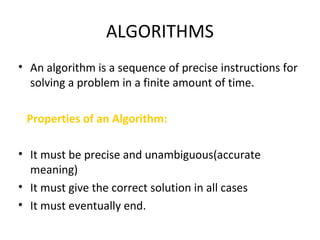


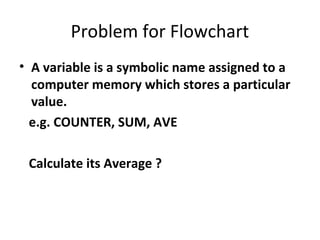





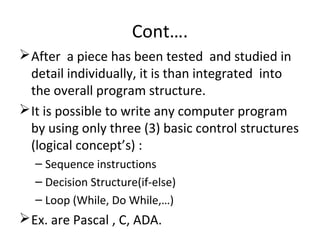








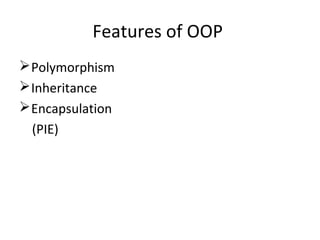


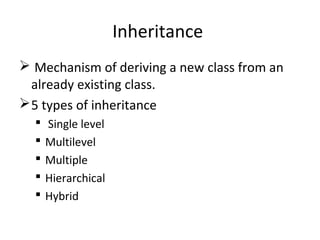
















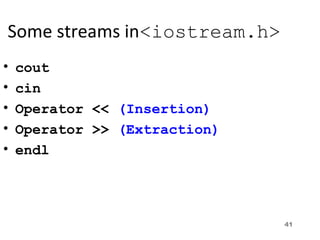
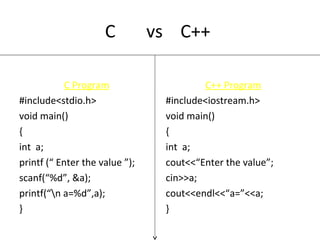



![46
Structures
#include<iostream.h>
Void main() {
struct book{
int page_no;
char name[15];
};
book b1;
b1.page_no=125;
b1.name =“oops”;
cout <<“Book Name"<< b1.name <<“Book
page no"<< b1.page_no <<endl; }](https://image.slidesharecdn.com/oops-180909121829/85/Oop-object-oriented-programming-46-320.jpg)

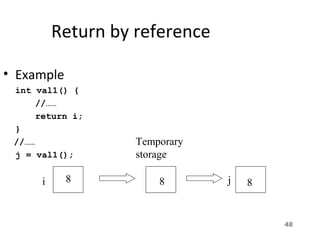
![Matrix Multiplication
#include<iostream.h>
#include<conio.h>
void main()
{
int row1,col1,row2,col2;
int i,j,k;
int mat1[5][5],mat2[5][5],multi[5][5];
clrscr();
cout<<"enter the row for first matrixn";](https://image.slidesharecdn.com/oops-180909121829/85/Oop-object-oriented-programming-49-320.jpg)
![cin>>row1;
cout<<"enter column for first matrixn";
cin>>col1;
cout<<"enter elements of first matrixn";
for(i=0;i<row1;i++)
{
for(j=0;j<col1;j++)
{
cin>>mat1[i][j];
}
}
cout<<"enter the row of second matrixn";
cin>>row2;
cout<<"enter column for second matrixn";
cin>>col2;
cout<<"enter elements of second matrixn";](https://image.slidesharecdn.com/oops-180909121829/85/Oop-object-oriented-programming-50-320.jpg)
![for(i=0;i<row2;i++)
{
for(j=0;j<col2;j++)
{
cin>>mat2[i][j];
}
}
if(col1==row2)
{
cout<<"multiplication of matrices isn";
for(i=0;i<row1;i++)
{
for(j=0;j<col1;j++)
{](https://image.slidesharecdn.com/oops-180909121829/85/Oop-object-oriented-programming-51-320.jpg)
![multi[i][j]=0;
for(k=0;k<col1;k++)
{
multi[i][j]+=mat1[i][k]*mat2[k][j];
}
cout<<multi[i][j];
}
cout<<endl;
}
}
else
cout<<"multiplication is not compatible";
getch();
}](https://image.slidesharecdn.com/oops-180909121829/85/Oop-object-oriented-programming-52-320.jpg)


